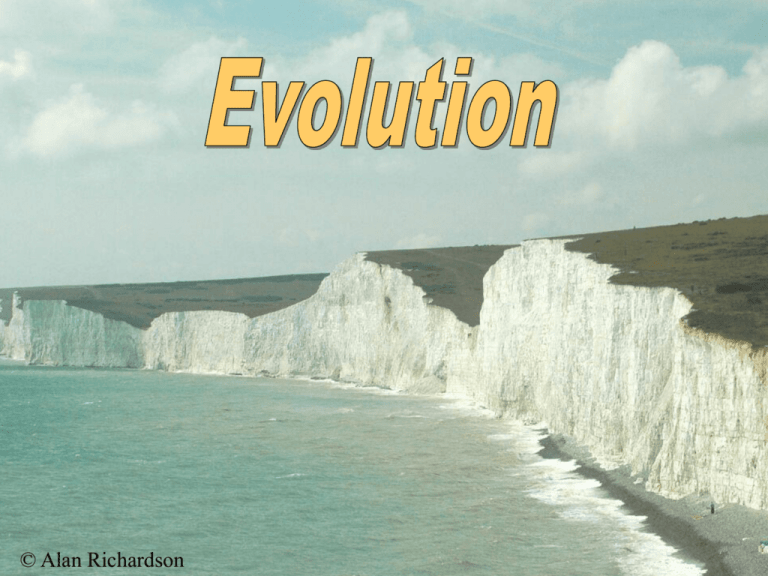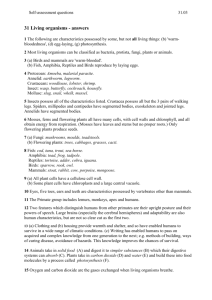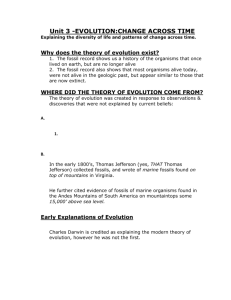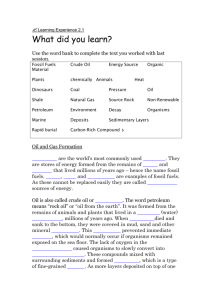Evolution Powerpoints
advertisement

© Alan Richardson 2 The theory of evolution offers an explanation for the existence of all living organisms on the Earth today and in the past It supposes that present day organisms have all been derived from organisms that lived in the past By a series of very small changes over millions of years new species have developed from previous species* Over a period of about 3000 million years, many new species have been produced and many have become extinct. We know a great deal about the organisms that lived millions of years ago from studying their fossilised remains. 3 Fossil formation There are many ways in which an organism can be fossilised One of these ways is shown in the next sequence of slides In principle, a fossil is formed when an organism dies, its body is enclosed in mud, or sand. The soft parts decay but some of the hard parts (skeleton, shells, seeds) are preserved The mud or sand eventually becomes rock and the hard parts of the organism are mineralised. When the rock is exposed as a result of earth movements or erosion, the fossil remains can be dug out and studied. The sediment eventually becomes rock Fish B becomes a fossil much later than fish A The deeper the rock layer, the older the fossil Living fish B Dies Enclosed in sediment Hard parts fossilised Living fish A Dies Enclosed in sediment Hard parts fossilised 4 5 living fish sediment from river fish skeleton partly buried by sediment 6 more recent sediment collects older sediment becomes rock fish skeleton fossilised land raised above water level 7 recent rock older rock 8 fossilised skeleton exposed earth movements fracture rock 9 When rock strata become exposed, it can be assumed that, in most cases, the lowest layers are the oldest* This means that the fossils of organisms preserved in the lowest layers represent animals and plants that lived many millions of years ago rock strata of increasing age © Alan Richardson 10 This is a fossil of a fish which lived 40 million years ago © Alan Richardson 11 This is a reconstruction, from fossil remains, of an ‘armour-plated’ fish which lived 350 million years ago dorsal fin The fish which gave rise to fossils such as this, were very different from today’s fish 12 By studying the type of fossils and the abundance of each species in the different strata, it is possible to build up a picture of how the populations of organisms changed over millions of years The next slide shows how this picture appears for vertebrate animals The width of each band represents the relative abundance of the organisms as judged by their fossil remains. For example, 100 million years ago there were many more species of reptiles than there are today Mammals do not appear at all in rocks older than about 3 million years 13 Relative number of species mammals birds reptiles 100 million years ago amphibia 200 million years ago fish 300 million years ago o o o o o o o 400 million years ago o o o o o o o o o o o o o o o o o o o o o o o o o o o o o o o o Possible lines of evolution Interpretation of the fossil record (1) In interpreting the fossil record, it must be borne in mind that fossils will be formed only in places and at times when conditions are suitable for fossilization. So they may not be representative of the organisms living at that time 1 only the skeletons, shells and other parts resistant to decay will be preserved 2 fossils are found only if they are exposed by Earth movements or erosion 3 very few fossils have been found which show intermediate stages between different groups of organism 4 14 15 Interpreting the fossil record (2) Despite its gaps, the fossil record does show that, over millions of years, organisms became more numerous and more diverse, i.e. many more species came into existence 1 organisms became more complex 2 although very few organisms found as fossils are alive today, there are many basic similarities in the body structure of the fossils and similar organisms living today 3 although they are few, there are fossils which show characteristics intermediate between major groups4 16 claws wing-like forelimbs teeth thin ribs long tail feathers Replica of Archaeopteryx fossil; half bird half reptile © Alan Richardson Reptile-like features Bird-like features 18 Evidence from comparative anatomy Fish, amphibia, reptiles, birds and mammals all have vertebral columns, skulls, brains, circulatory systems and many other features in common This suggests that they all arose from a common ancestral form rather than arising independently. The same reasoning can be applied to other groups of organisms such as insects which have most of their anatomical features in common Although these features are superficially different there is a basic pattern underlying them all 17 Vertebrate limbs The basic pattern of the vertebrate limb is represented by the human arm skeleton shown below ball and socket joint single bone hinge joint two bones group of small bones five jointed digits 19 The forelimbs of the following vertebrates show the basic pattern of limb bones with modifications which are adapted to their methods of locomotion. The basic pattern suggests they have evolved from a common ancestor Lizard Dolphin Bird Bat 20 DNA evidence Another important line of evidence for evolution comes from DNA analysis Any permanent change in form or function of an organism must be preceded by a change in its DNA Organisms which have much of their DNA in common must be closely related, i.e. they have split from a common ancestor comparatively recently (in geological terms) For example, humans and chimpanzees have 99% of their DNA in common which suggests a close relationship and relatively ‘recent’ divergence from a common ancestor 21 Evolutionary pathways The next slide shows the widely accepted pathway of evolution for plants and animals Only a few of the main types of organisms are shown 22 Monocots Herbs Shrubs Trees Birds Mammals Reptiles Dicots Amphibia Fish Flowering plants Conifers Mosses Insects Ferns Crustacea Annelids Liverworts Mollusc Flatworms Coelenterates Algae Fungi Multicellular plants Multicellular animals Single celled organisms 23 Dave. ‘A bloke on the telly just said that before we were humans we were monkeys’. Mick. ‘What were we before that?’ Dave. ‘ I don’t know. I can’t even remember being a monkey’ 24 Dave is wrong Dave’s view of evolution 25 Dave seems to think that evolution can take place in a person’s lifetime. This is pretty bizarre, even for Dave. He has also confused monkeys with apes. Our nearest relatives are apes (chimpanzees and gorillas), not monkeys He makes the common error that, e.g. fish, as we know them today gave rise to amphibia and, by the same reasoning, apes, as we know them, gave rise to humans The correct interpretation of the evidence is that apes and humans had a common ancestor which was neither ape nor human In the course of evolution, this common ancestor produced two lines of descendants, culminating in modern day humans and modern day apes 26 The accepted view of evolution 28 Question 1 Evolution has taken place over (a) hundreds (b) thousands (c) millions (d) billions of years 29 Question 2 Fossils can be formed only if total decay (a) is prevented (b) is accelerated (c) is slowed up (d) is immediate 30 Question 3 Older fossils are found (a) in the deepest rock layers (b) in the shallowest rock layers (c) only in rocks over 1 million years old (d) evenly dispersed in all rock layers 31 Question 4 Which of these statements is correct ? Fossilised organisms (a) are all totally different from present-day species (b) are much the same as present-day species (c) often show strong resemblances to present-day species (d) are never related to other fossilised organisms 32 Question 5 The order of appearance of vertebrates in the fossil record is (a) Birds and mammals; reptiles; amphibians; fish (b) Fish; amphibians; reptiles; birds and mammals (c) Fish; reptiles; amphibians; birds and mammals (d) Amphibians; fish; reptiles; birds and mammals 33 Question 6 Reptiles were most abundant (a) 400 million years ago (b) 300 million years ago (c) 200 million years ago (d) 100 million years ago 34 Question 7 Archaeopteryx is a fossil which shows features intermediate between (a) reptiles and mammals (b) reptiles and birds (c) birds and mammals (d) reptiles and amphibians 35 Question 8 Which statement is correct ? (a) Amphibia are derived from fish (b) Amphibia evolved into reptiles (c) Amphibia and fish share a common ancestor (d) Reptiles evolved into mammals 36 Answer Correct 37 Answer Incorrect






